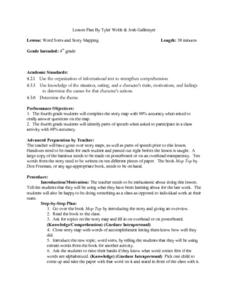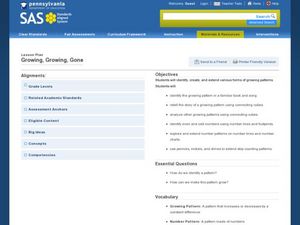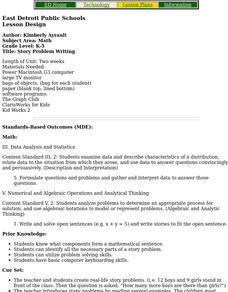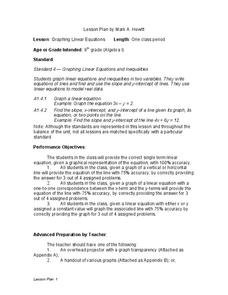Curated OER
Bridge Cable Corrosion
Students investigate the corrosion of different materials in the lab. In this chemistry lesson, students construct a bridge considering different bridge designs. At the end of the lesson, they play the role of scientists and engineers...
Curated OER
Senior Classroom Census
Students recall the data collection cycle and engage in the data collection process. They record data, represent it in graphical form and anlyze and question the data. In addition, they decide how census data can be used for
planning.
Curated OER
Minting a New Mint
Students explore why the Founding Fathers felt it was necessary to have a solitary form of money used throughout the land. Students create their own money systems and have a class sale to simulate the confusion of multiple forms of...
Curated OER
Word Sorts And Story Mapping
Fourth graders engage in a lesson plan that covers the concept of using a storymap to increase reading comprehension. They possess the prior knowledge of parts of speech from previous lessons. Students fill in the blank storymap while...
Missouri Department of Elementary
If It’s to Be, It’s Up to Me
Here's a clever switch on the tale of Pandora's Box. Rather than lifting the lid and having problems escape, class members write a problem on a strip of paper and place it in Pandora's Problem Box. A student then pulls a problem...
Curated OER
Word Wall Words
Students use the basic required 200 words by sight in sentences of three to six words, use the words to play bingo and rhyming word activity.
Curated OER
Red Circle, Red Circle, What Do You See?
Young learners explore shapes and colors. They listen to Brown Bear, Brown Bear What Do You See? by Bill Martin Jr. and use the same language pattern to create a color and shape book of their own. After that, with the leftover magazine...
Curated OER
The Art of Protesting
Students view various images to examine different types of protest Americans have used throughout history, and explore ways in which protest can produce change for better or worse.
Curated OER
Speciation and Genetic Drift Worksheet
Fifteen terms pertaining to speciation, extinction, and gene flow are to be matched to their definitions. This simple, easy-to-read worksheet can be used as a pop quiz for your biology learners when studying natural selection principles...
Curated OER
Energy Efficiency Ambassadors
High schoolers research energy conservation devices. They also create their own light efficiency project and presents their findings on science fair night.
Curated OER
The Missing Link
What is the missing link? Provide your class with this incomplete essay (it's missing transition words), and have writers place words from the transition word bank into the essay. Also, since only three of the five paragraphs are...
Curated OER
Growing, Growing, Gone
Budding mathematicians identify growing patterns in numbers and songs then create their own patterns. They look at number patterns and language patterns and then create their own using money and footprints.
Curated OER
Creating Family Trees
Students make presentations about families. They make family trees and present orally to the class.
Curated OER
Story Problem Writing
Students write story problems which can only be solved with the application of multiplication facts. They write an extra fact that isn't needed to solve. When their partners do the problems, they must cross out the fact that they do need.
Curated OER
Graphing With Second Graders
Second graders sort M & M's and then enter the data into a spreadsheet in order to create a simple graph. After printing the spreadsheet generated graph, have students compare the printed graph with their paper graph.
Curated OER
Introduction to Law I
Young scholars identify four basic values (economic, social, moral, and political) protected by law, examine different definitions of values, and correlate laws to values they aim to protect.
Curated OER
Cloze Instruction And Herringbone Technique
Students sort out important information and create a visual framework for reviewing in the future. They organize a large quantity of information thus helping with learning and remembering details, cause and effect, comparison and...
Curated OER
Graphing Linear Equations
Ninth graders review the information that they have already learned
with regard to linear equations and graphical representations. They then assist in combining equations with a graphical element and complete various graphs with this...
Curated OER
Elements and Principles Using a Movie
Students identify the elements and principles that appear in an illustration of a room and explain each concept in writing. They watch this movie identifying each of the elements and principles of design portrayed in the interiors of...
Curated OER
Your Beating Heart - Circulatory System
Students illustrate a schematic circulatory system of a human body including heart, lungs, arteries, veins and capillaries. Next, students conduct an experiment to increase understanding of the relationship between heart rate/pulse and...
Curated OER
Media Analysis--Culture and Gender Roles
Ninth graders participate in class discussion about culture and how it influences our lives then complete an analysis of advertisements from popular magazines to derive what effects they have on our culture. They use analysis of adds to...
Curated OER
Mice are Nice 80
Students complete a variety of mouse-themed activities. They listen to stories, recite poetry, identify rhyming words, write sentences, create art projects, take a survey and design an original mousetrap.
Curated OER
I Have a Magic Pot
Pupils will explore numbers rules. They will create a picture of their rule and exchange their paper with a classmate. The classmate works to figure out the rule. They then share with each other how they found the rule. Questions are...
Curated OER
If It's to Be, It's Up to Me!
Eighth graders discuss the question: How does one become an effective decision-maker or problem solver in social situations? They are given three brief scenarios and after each one students are asked, "What would you do?" Students think...























